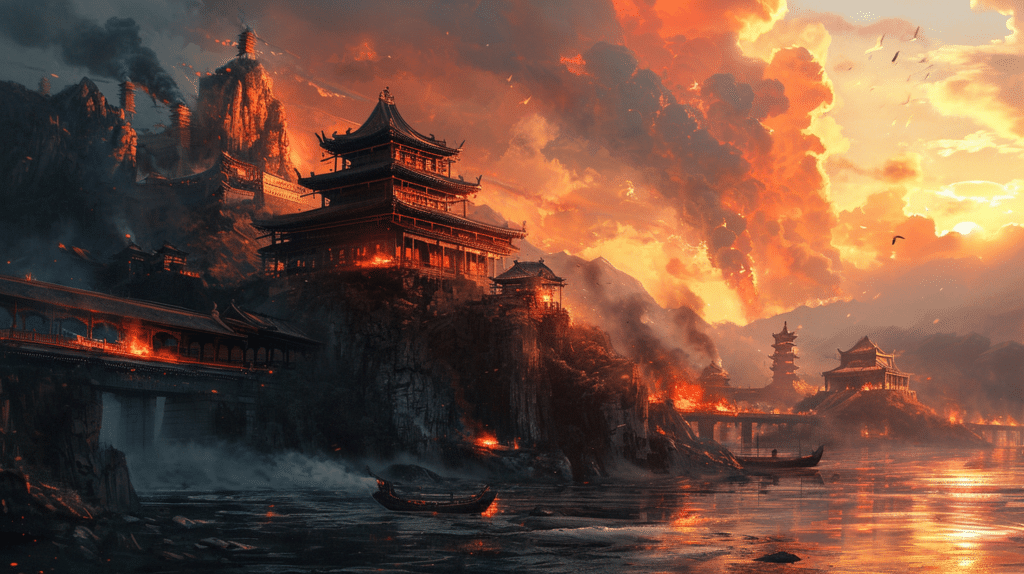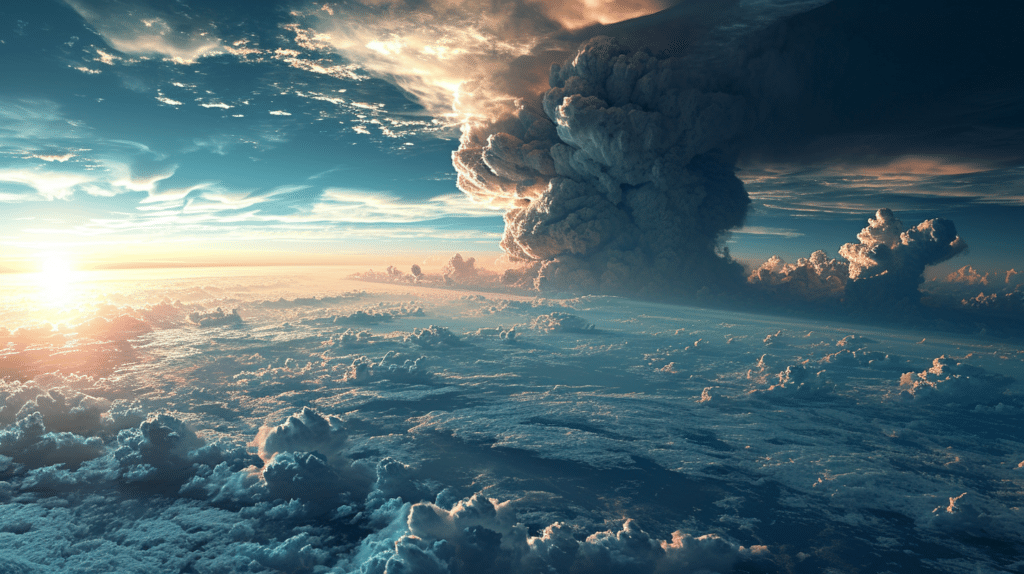As tensions between nations escalate, the world holds its breath, anticipating the outbreak of World War 3. The geopolitical landscape is fraught with rivalries and power struggles, creating a volatile environment where a single spark could ignite a catastrophic conflict. The stakes are high, with global superpowers vying for dominance and smaller nations caught in the crossfire. The world watches anxiously as the tension rises, knowing that the consequences of this conflict could be devastating.

The Trigger Event: Sparking the Conflict
The trigger event that ignited the flames of World War 3 was the Islamic empires’ restriction on Christian pilgrimage to the Holy Land. This restriction created deep resentment and tension between the Christian and Islamic worlds. The Crusades were a direct result of this conflict, as Christian nations sought to regain access to the sacred sites in Jerusalem. The Crusades marked the beginning of a long and bloody war that would shape the course of history.
The Major Players in World War 3
Superpowers Collide: USA vs China
The clash between the United States and China is a high-stakes battle for global dominance. Both superpowers are ramping up their military and diplomatic efforts in Asia as they seek to outdo each other. The US, in a ‘once in a generation effort’, is boosting its military ties in the region to counter China’s growing influence. This escalating rivalry has the potential to reshape the geopolitical landscape and impact nations around the world. As tensions rise, the world watches with bated breath to see how this clash of titans unfolds.

The European Union’s Role in the Conflict
The European Union (EU) plays a crucial role in the cataclysmic conflict of World War 3. As a political and economic union comprising 27 member states, the EU wields significant influence on the global stage. In the face of escalating tensions, the EU has been actively engaged in diplomatic efforts to de-escalate the situation and promote peace. Through its collective security and defense policies, the EU aims to ensure the stability and security of its member states and the wider region.
The EU has also been instrumental in providing humanitarian aid and support to affected regions. It has mobilized resources and coordinated relief efforts to assist impacted communities. Additionally, the EU has implemented economic sanctions and trade restrictions to exert pressure on aggressor nations and deter further escalation of the conflict.
In the words of The Secret Teachings with Ryan Gable, ‘The European Union’s involvement in World War 3 highlights the importance of international cooperation and diplomacy in times of crisis.’ The EU’s role in this conflict underscores the complex dynamics and interconnectedness of global politics and the need for collaborative efforts to maintain peace and stability.
Russia’s Ambitions and Involvement
Russia plays a significant role in the cataclysmic conflict of World War 3. With its vast territory and military might, Russia has its own ambitions and interests in the outcome of the war. One of Russia’s main objectives is to expand its influence and regain its status as a global superpower. The country seeks to assert its dominance in Eastern Europe and Central Asia, aiming to establish a sphere of influence over neighboring countries. Additionally, Russia has been actively involved in supporting proxy forces and engaging in cyber warfare to destabilize its adversaries. The involvement of Russia in World War 3 adds another layer of complexity to the already volatile global situation.
The Battlefield: Global Hotspots
The Middle East: A Powder Keg
The Middle East has long been a region of intense geopolitical tensions and conflicts. With its rich history, diverse cultures, and strategic location, it has become a powder keg waiting to explode. The ongoing power struggles, religious rivalries, and territorial disputes have created a volatile environment that could easily ignite a global conflict. The presence of major world powers and their competing interests further complicates the situation, turning the region into a battleground for proxy wars. The Middle East is a ticking time bomb, and the consequences of its explosion would be catastrophic.
Asia-Pacific: A Region on the Brink
The Asia-Pacific region is a powder keg of geopolitical tensions and economic rivalries. With major powers like China, the United States, and Japan vying for influence, the stakes are high. Business leaders in the region are on the brink of a historic moment in the battle against inequality.
How they respond could have far-reaching consequences for the future. According to a report by PwC, the Net Zero Economy Index Asia Pacific Cut 2023, the region has the potential to lead the world in transitioning to a sustainable and inclusive economy. This is a critical opportunity for countries in the region to address pressing issues such as climate change, poverty, and social inequality.
By embracing sustainable practices and investing in green technologies, the Asia-Pacific region can not only mitigate the risks of conflict but also pave the way for a brighter and more prosperous future.

Europe: Caught in the Crossfire
As World War 3 unfolds, Europe finds itself in a precarious position, caught in the crossfire of global powers. With its strategic location and historical significance, Europe becomes a battleground for competing interests. The major players in the conflict, such as the United States, China, and Russia, vie for control and influence over European nations.
Support more articles like this.
Weapons of Mass Destruction: Unleashing Hell
Nuclear Armageddon: The Ultimate Threat
The threat of nuclear weapons is a grave concern in the context of World War 3. International bodies and proliferation experts warn that the danger of nuclear weapons use is higher than it’s been in decades. The destructive power of these weapons is unimaginable, capable of wiping out entire cities and causing long-lasting environmental damage. The potential for accidental or intentional use of nuclear weapons is a constant source of anxiety for the global community. Efforts to prevent nuclear proliferation and promote disarmament are crucial in order to avoid the catastrophic consequences of a nuclear Armageddon.

Biological Warfare: Silent and Deadly
Biological warfare is a terrifying form of warfare that utilizes deadly pathogens and toxins to cause widespread destruction and death. These weapons can be invisible and silent, making them difficult to detect and defend against. The use of biological weapons poses a significant threat to both military forces and civilian populations. The Biological Weapons Convention (BWC), also known as the Biological and Toxin Weapons Convention (BTWC), is a disarmament treaty that effectively bans biological and toxin weapons by prohibiting their development, production, acquisition, transfer, stockpiling, and use.
Peace with Biological Weapons
Opened for signature in 1972 and ratified by 188 countries, the BWC represents a landmark agreement in disarmament history. It prohibits the development and use of these devastating weapons and compels nations to destroy any existing stockpiles. The BWC aims to foster global security and peace, emphasizing that the use of biological weapons is utterly reprehensible.
The Threat Remains
Despite the BWC’s achievements, the threat of biological warfare persists. Advancements in biotechnology make it easier for rogue states and terrorist organizations to develop and deploy these weapons. Vigilance and international cooperation are essential to counter this menace, ensuring robust measures are in place to prevent proliferation.
In conclusion, while progress has been made in curbing the use of biological weapons, the evolving threat landscape requires continuous efforts to guarantee a safer world for future generations.
Cyber Attacks: The New Battlefield
In this digital age, cyber attacks have emerged as a new form of warfare. With nations increasingly reliant on technology, cyber threats loom large, capable of disrupting vital infrastructure and eroding public trust. In 2023, India faced a wave of cyber attacks, resulting in compromised data and operations. As technology evolves, so too do the tactics and tools involved in cyber warfare. Experts highlight that generative AI could redefine the battlefield, making cyber attacks more sophisticated and harder to detect.
The Human Cost: Lives Lost and Nations Destroyed
Millions Dead: The Toll of World War 3
World War 3 has left a devastating trail of destruction, with millions of lives lost in its wake. The scale of the conflict is unprecedented, surpassing even the deadliest wars in history. Entire cities lie in ruins, and communities once thriving have crumbled. The human cost is immeasurable, leaving behind a legacy of pain and suffering that will echo through generations.
The toll of World War 3 extends beyond mere loss of life. Its economic repercussions are catastrophic, plunging global markets into turmoil and driving nations toward the brink of collapse. Infrastructure has been obliterated, complicating rebuilding efforts. Meanwhile, the refugee crisis has reached alarming proportions, with millions displaced from their homes, seeking refuge in overcrowded camps. The social fabric of societies has been torn apart, forcing communities to grapple with the aftermath of these tragic events.
In the face of such devastation, the international community must unite to support those affected by World War 3. Humanitarian assistance is vital to alleviating suffering and rebuilding shattered lives. Diplomatic initiatives must also be ramped up, with a focus on finding peaceful resolutions and preventing future conflicts. Only through collective action and cooperation can we hope to forge a world where the horrors of World War 3 are permanently relegated to the past.

Refugee Crisis: Displaced and Desperate
The refugee crisis spurred by World War 3 has prompted unprecedented displacement and despair. Millions of people have fled their homes, seeking safety and refuge across borders or continents. The scale of this humanitarian crisis is staggering, with Syria alone accounting for around 25% of the global refugee population.
As of mid-2023, 6.49 million Syrians have been displaced. This highlights the magnitude of the humanitarian challenges that lie ahead. The ramifications of the refugee crisis extend beyond immediate needs, straining host countries and creating significant social, economic, and political challenges.
Economic Collapse: The Aftermath of Destruction
The economic collapse that follows the devastation of World War 3 is nothing short of catastrophic. Nations that once thrived are now in ruins, grappling with shattered economies. The loss of infrastructure, resources, and skilled labor leaves countries struggling to rebuild. Hyperinflation creates skyrocketing prices and renders currencies worthless. The global financial system is in disarray, with banks failing and markets spiraling out of control. It’s a bleak and desperate time for the survivors.
In the aftermath, nations face a myriad of challenges. Unemployment soars as businesses crumble and industries collapse. The lack of jobs spirals into widespread poverty and social unrest, while governments struggle to provide basic services to their citizens. Food shortages become a grim reality as agricultural production falters and supply chains break down. People are forced to ration their essentials and search for scraps to survive.
The collapse also triggers geopolitical transformations. Power dynamics shift dramatically as previously dominant nations lose their grip, while emerging powers seize opportunities to assert themselves. Alliances are formed and dismantled as countries scramble to secure resources and stabilize their economies. The global order, as we know it, will be forever altered.
Rebuilding from this economic wreckage will be monumental. It requires not just reconstruction efforts but the healing of societies and the restoration of trust. International cooperation and assistance will play a crucial role in this process. Investment in infrastructure, education, and healthcare is essential to lay the groundwork for sustainable growth. While the journey is long and fraught with challenges, determination and resilience may allow nations to rise from the ashes and build a better future.
The Endgame: Seeking Peace in the Chaos
Diplomatic Efforts: Can Talks Prevent Disaster?
Amid the chaos of World War 3, diplomatic efforts stand as a beacon of hope. As nations grapple with the fallout of conflict, leaders from across the globe gather for high-stakes negotiations. Their mission: secure a peaceful resolution and stave off further calamity.
These diplomatic initiatives are not without their obstacles. Deep-rooted hostilities, conflicting interests, and power struggles could threaten any prospect for progress. But the alternative? Unthinkable. The world cannot afford to let war consume more lives and nations.
International organizations such as the United Nations are key players in this diplomatic dance. They serve as neutral grounds for dialogue and mediation, uniting representatives from diverse sides. These organizations work tirelessly to bridge divides and establish common ground.
But can mere talks avert disaster? The answer is complicated. While diplomacy offers pathways to peace, it necessitates genuine commitment and a willingness to compromise. It demands that leaders prioritize the welfare of their people over personal ambitions. It’s about recognizing our shared humanity and understanding that warfare is not the solution.
With immense challenges ahead, the world closely watches these diplomatic ventures—part hope, part skepticism. The stakes are high, and failing to succeed could have dire consequences. However, if these talks prosper, they present the chance to save lives, rebuild nations, and create a future free from the scourge of a third world war.

The Role of International Organizations
International organizations are pivotal in alleviating the impact of World War 3 while striving for peace. Their platforms enable crucial dialogue and analysis on the conflict, illuminating the complexities of the war’s impact on nations. They also facilitate diplomatic efforts by bringing representatives from varying nations together to seek peaceful resolutions, playing an instrumental role in rebuilding efforts.
Rebuilding Nations: From Ashes to Hope
After the devastation of World War 3, the arduous task of reconstruction falls to governments, aid organizations, and resilient communities. The journey toward recovery is long, but it isn’t devoid of hope. Governments and organizations have mobilized resources to provide immediate relief and essential support to those affected. Focus is not only on immediate needs but also on laying the groundwork for long-term recovery. Amidst the many challenges, a glimmer of hope emerges as communities rally together to rebuild and restore what was lost.
In chaos and uncertainty, finding peace may feel impossible, but there are organizations dedicated to exposing the truth behind cryptic politics and conspiracies affecting our world. For insights, exploration, and discourse on these pressing issues, visit Unexplained.co today to join the national conversation.
In Conclusion
World War 3—The Cataclysmic Conflict That Rattles Nations has scrutinized the possible causes, consequences, and implications of what looms as a global conflict. From the devastating effects inflicted upon human lives and infrastructure to social and economic chaos, this article has cast light on the catastrophic nature of such an event. It is paramount for nations to prioritize diplomacy, peace-building, and international collaboration in order to avert such a dire conflict. History’s lessons must guide us toward a future defined by stability and peace.
Frequently Asked Questions
What were the main causes of World War 3?
The main causes of World War 3 included escalating tensions between superpowers, a trigger event that sparked the conflict, and the ambitions and involvement of major players like the USA, China, Russia, and the European Union.
Which regions were the major battlegrounds in World War 3?
The major battlegrounds in World War 3 included the Middle East, Asia-Pacific, and Europe.
What were the weapons of mass destruction used in World War 3?
The weapons of mass destruction utilized in World War 3 included nuclear weapons, biological warfare, and cyber attacks.
How many lives were lost in World War 3?
Millions of lives were lost in World War 3, resulting in unimaginable humanitarian costs.
What were the consequences of World War 3?
The consequences of World War 3 included a severe refugee crisis, economic collapse, and the obliteration of entire nations.
Were there any efforts to seek peace during World War 3?
Absolutely, there were extensive diplomatic efforts alongside the involvement of international organizations committed to fostering peace and facilitating post-war recovery.




